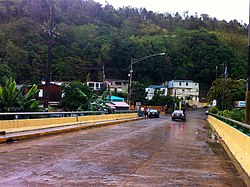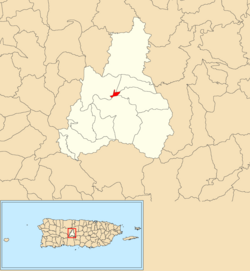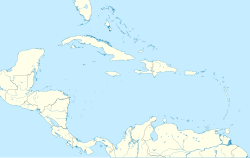Jayuya barrio-pueblo is a barrio and the administrative center (seat) of Jayuya, a municipality of Puerto Rico. Its population in 2010 was 1,222.[1][4][5][6]
Jayuya barrio-pueblo
Pueblo de Jayuya | |
|---|---|
Municipality Seat[1] | |
 Bridge over Río Grande in Jayuya (PR 141R), entrance to barrio-pueblo on the left | |
 Location of Jayuya barrio-pueblo within the municipality of Jayuya shown in red | |
| Coordinates: 18°13′11″N 66°35′33″W / 18.219831°N 66.592566°W[2] | |
| Commonwealth | |
| Municipality | |
| Area | |
• Total | 0.14 sq mi (0.4 km2) |
| • Land | 0.14 sq mi (0.4 km2) |
| • Water | 0.00 sq mi (0.0 km2) |
| Elevation | 1,509 ft (460 m) |
| Population (2010) | |
• Total | 1,222 |
| • Density | 8,728.6/sq mi (3,370.1/km2) |
| Source: 2010 Census | |
| Time zone | UTC−4 (AST) |
As was customary in Spain, in Puerto Rico, the municipality has a barrio called pueblo which contains a central plaza, the municipal buildings (city hall), and a Catholic church. Fiestas patronales (patron saint festivals) are held in the central plaza every year.[7][8]
| Census | Pop. | Note | %± |
|---|---|---|---|
| 1910 | 4,746 | — | |
| 1920 | 5,734 | 20.8% | |
| 1930 | 4,808 | −16.1% | |
| 1940 | 1,808 | −62.4% | |
| 1950 | 2,318 | 28.2% | |
| 1960 | 2,344 | 1.1% | |
| 1970 | 0 | −100.0% | |
| 1980 | 2,042 | — | |
| 1990 | 1,565 | −23.4% | |
| 2000 | 1,720 | 9.9% | |
| 2010 | 1,222 | −29.0% | |
| U.S. Decennial Census 1900 (N/A)[9] 1910-1930[10] 1930-1950[11] 1980-2000[12] 2010[13] | |||
The central plaza and its church
editThe central plaza, or square, is a place for official and unofficial recreational events and a place where people can gather and socialize from dusk to dawn. The Laws of the Indies, Spanish law, which regulated life in Puerto Rico in the early 19th century, stated the plaza's purpose was for "the parties" (celebrations, festivities) (Spanish: a propósito para las fiestas), and that the square should be proportionally large enough for the number of neighbors (Spanish: grandeza proporcionada al número de vecinos). These Spanish regulations also stated that the streets nearby should be comfortable portals for passersby, protecting them from the elements: sun and rain.[7]
Located across the central plaza in Jayuya barrio-pueblo is the Parroquia Nuestra Señora de la Monserrate, a Roman Catholic church.[14]
See also
editReferences
edit- ^ a b Puerto Rico: 2010 Population and Housing Unit Counts.pdf (PDF). U.S. Dept. of Commerce, Economics and Statistics Administration, U.S. Census Bureau. 2010.
- ^ a b "US Gazetteer 2019". US Census. US Government.
- ^ U.S. Geological Survey Geographic Names Information System: Jayuya barrio-pueblo
- ^ Picó, Rafael; Buitrago de Santiago, Zayda; Berrios, Hector H. Nueva geografía de Puerto Rico: física, económica, y social, por Rafael Picó. Con la colaboración de Zayda Buitrago de Santiago y Héctor H. Berrios. San Juan Editorial Universitaria, Universidad de Puerto Rico,1969.
- ^ Gwillim Law (20 May 2015). Administrative Subdivisions of Countries: A Comprehensive World Reference, 1900 through 1998. McFarland. p. 300. ISBN 978-1-4766-0447-3. Retrieved 25 December 2018.
- ^ "US Census Barrio-Pueblo definition". factfinder.com. US Census. Archived from the original on 13 May 2017. Retrieved 5 January 2019.
- ^ a b Santullano, Luis A. (10 March 2019). "La Plaza y la Calle". Mirada al Caribe. Vol. 54. Colegio de Mexico. pp. 75–78. doi:10.2307/j.ctvbcd2vs.12. JSTOR j.ctvbcd2vs.12.
- ^ Pariser, Harry S. (2003). Explore Puerto Rico, Fifth Edition. San Francisco: Manatee Press. pp. 52–55. Retrieved 10 February 2019.
- ^ "Report of the Census of Porto Rico 1899". War Department Office Director Census of Porto Rico. Archived from the original on July 16, 2017. Retrieved September 21, 2017.
- ^ "Table 3-Population of Municipalities: 1930 1920 and 1910" (PDF). United States Census Bureau. Archived (PDF) from the original on August 17, 2017. Retrieved September 21, 2017.
- ^ "Table 4-Area and Population of Municipalities Urban and Rural: 1930 to 1950" (PDF). United States Census Bureau. Archived (PDF) from the original on August 30, 2015. Retrieved September 21, 2014.
- ^ "Table 2 Population and Housing Units: 1960 to 2000" (PDF). United States Census Bureau. Archived (PDF) from the original on July 24, 2017. Retrieved September 21, 2017.
- ^ Puerto Rico: 2010 Population and Housing Unit Counts.pdf (PDF). U.S. Dept. of Commerce Economics and Statistics Administration U.S. Census Bureau. 2010. Archived (PDF) from the original on 2017-02-20. Retrieved 2019-08-02.
- ^ Mari Mut, José A. (2013-08-28). Los Pueblos de Puerto Rico y Las Iglesias de Sus Plazas [The Pueblos of Puerto Rico, and the Churches of its Plazas] (PDF) (in Spanish). Archived (PDF) from the original on 2020-12-14. Retrieved 2021-09-16.
External links
edit
